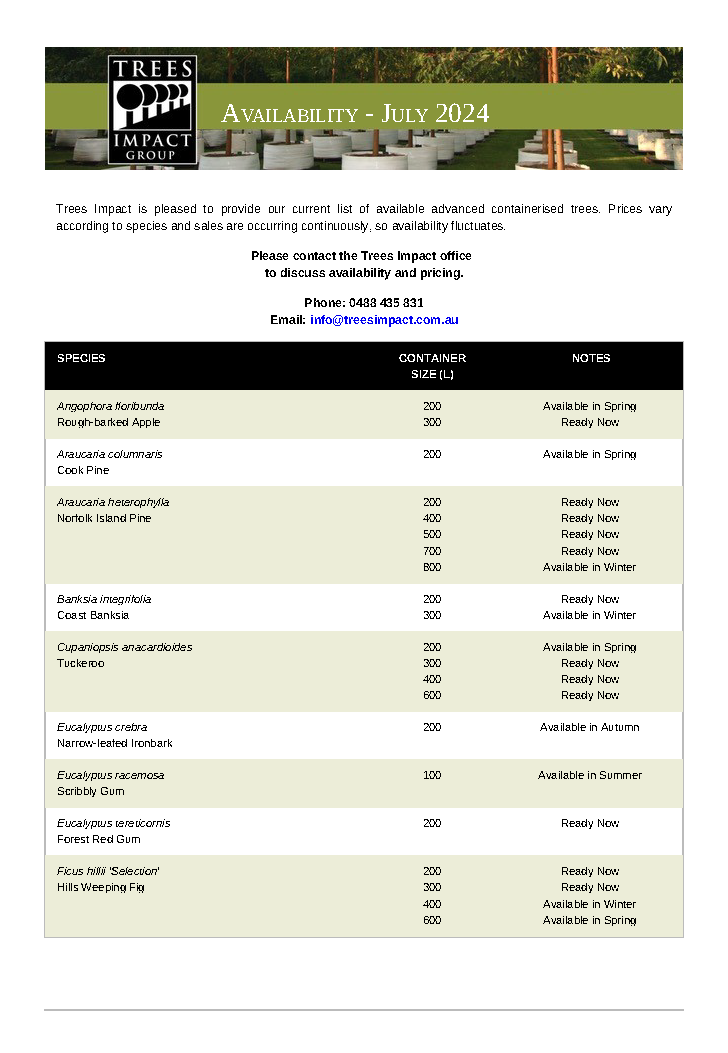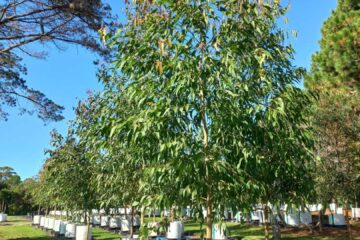AS 2303 PART 2. ASSESSING FOR CONFORMITY
Assessing trees using ‘AS 2303:2018 – Tree stock for landscape use’
The new Australian standard AS 2303:2018 (Tree stock for landscape use) is now out and can be applied to tree stock for your projects. Include it in your documentation and requests for tree supply then assess the trees supplied against it.
A logical approach to assessing trees against AS 2303 was outlined in the Outreach tour recently conducted by Western Sydney University, in association with the Nursery and Garden Industry Australia and Hort Innovation. It can be described as follows:
After placing the tree on a firm surface and removing any stakes or supports (do not remove the container at this stage):
- Assess “the tree you can see”
This preliminary stage of assessment addresses those criteria that are clearly visible. These more obvious criteria may be grouped as follows:
a. Check that; the tree is True to type and labeled correctly (where appropriate), the tree is healthy and free from any active pests or diseases, the crown is symmetrical and that the tree has not suffered any significant injury.
b. Check the stem is tapered and that the tree can support itself without stakes or other artificial supports.
c. Check that the clean stem height is less than 40% of total tree height and that branches are always smaller than the stems (preferably less than 50% of stem diameter immediately above the branch junction).
d. Check that all pruning cuts are at the branch junction and don’t exceed 50% of the stem diameter immediately above the point of pruning, and that all formative pruning is “best practice” (in accordance with AS 4373),
e. Where a defined central leader is appropriate for the size and species, check that the terminal bud is intact and that main stem upright.
f. Where the species has branch dominance, check that; terminal buds are intact, stem and branch unions are sound and that the clear stem height equals or exceeds any specific requirement.
g. Check that; there are no bark inclusions, the trunk is roughly in the middle of the rootball and that any graft unions present are sound.
- Assess Tree stock balance
For trees in 20L containers or larger, measure and record the height and caliper. Multiply the height (m) x caliper (mm) to generate the Size index then check that the Size Index falls within “the Preferred range” (as found in Appendix D of the new standard).
[The Size Index should fall within the preferred range for the vast majority of species and container sizes. However, there will be some instances where deviations will be acceptable – eg for some of our more unusual species (like Agathis robusta) and/or where the tree is in a very big size (say, 700L and up). In those instances where Size Index falls outside the Preferred Range and you feel that there is a case to be made to allow this, satisfy yourself that the tree is worth considering before progressing to below-ground assessment.]
- Assess the tree below-ground
If, having assessed “the tree you can see” and Tree stock balance, you are happy with the tree so far, proceed to check the following important aspects of “the tree below ground” before accepting the stock.
a. the root crown is at the uppermost surface of the rootball;
b. the rootball is wider than high and the depth does not exceed 660mm;
c. there is no suckering at the base;
d. the plant is free from pests, diseases and weeds within the rootball;
e. the rootball is fully occupied;
f. the roots are heading in an outwards or downwards direction and the rootball is free from: “J” roots; circling roots within the rootball; kinked roots; girdling roots; or woody circling roots at the extremity of the rootball. (For smaller trees, pull the rootball apart to inspect. For larger trees, wash out a section of the rootball so as to expose the root development from the stem to the outer edge of the rootball.)
g. the roots have divided regularly. (For tree stock in 45L containers or smaller, roots must have undergone primary division at least once, and for larger trees, roots must have undergone primary division at multiple intervals.)
- Accepting trees that do not fully conform?
In some circumstances you might choose to accept trees that do not conform to all criteria under AS 2303 provided the non-conformities do not compromise the trees’ ability to grow well. For example, buying trees that are slightly smaller than recommended might impact on ‘value for money’ but their ability to grow well, if all other criteria have been met, will not necessarily be diminished; or planting trees when the rootballs are not quite fully occupied may involve a little extra care (value for money again) but, given that care, they can grow perfectly well.
However, where the non-conformity is likely to adversely impact on the tree’s ability to thrive (eg roots fail to comply with all the criteria for root direction) the trees should not be considered.

